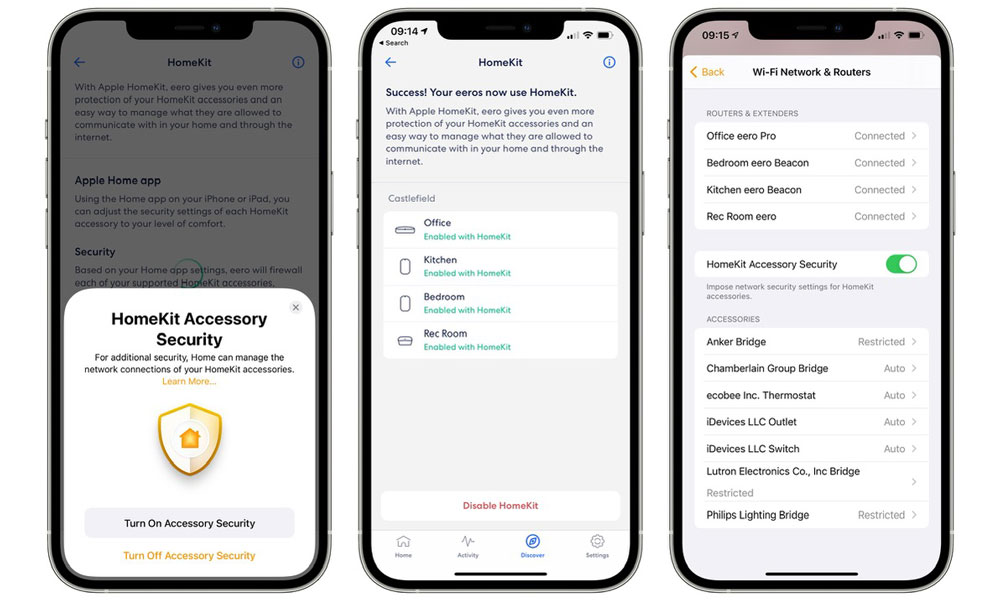Eero’s Wi-Fi 6 Routers Are Finally Getting HomeKit Support (Here’s What That Means)
 Credit: Eero / Amazon
Credit: Eero / AmazonToggle Dark Mode
The list of routers that support Apple’s HomeKit security features is pretty short, but at least it seems that HomeKit users who want to enjoy both improved home security and full Wi-Fi 6 support on their routers now have another option.
Last year, Eero became the first company to add HomeKit support to its routers, allowing users of Apple’s home accessory ecosystem to protect their home security and privacy by restricting how many of their Wi-Fi smart home devices could communicate with the outside world.
Unfortunately, when Eero unveiled its first Wi-Fi 6 router last fall, the Eero Pro 6, at least a few users were surprised to find that it lacked any direct support for HomeKit. It was an odd omission, considering the efforts that Eero had gone through to add it to the rest of its Eero routers, but considering that the one other HomeKit router — Linksys’ Velop system — suffered from the same limitation, we assumed it had something to do with Wi-Fi 6 making things a bit more complicated for manufacturers.
Earlier this year, Linksys specifically told us that HomeKit Secure Router support is on the way for its Velop Wi-Fi 6 systems via a firmware update, and while Eero was a bit more tight-lipped about its plans, it seemed like a safe bet that the Eero Pro 6 would eventually gain this feature as well.
Now it appears that Eero is quietly doing exactly that, with MacRumors reporting that a new firmware update is slowly rolling out to Eero Pro 6 users to add HomeKit support to the company’s newest routers.
What This Means
If you’re an Eero HomeKit user that’s been waiting to pull the trigger on upgrading to the Wi-Fi 6 version, you’ll be happy to know that the wait is finally over. Further, thanks to Eero’s modular mesh design, you can mix-and-match all Eero units, so you can add an Eero Pro 6 to get Wi-Fi 6 coverage in those areas of your home that need it, while continuing to use your existing Eero or Eero Beacon devices for spots where Wi-Fi 5 is just fine.
For those who are unfamiliar with HomeKit routers, these devices leverage a new HomeKit capability that Apple added in iOS 13.2 that can significantly improve the security of your HomeKit devices by making sure that they can’t communicate with anything except an Apple Home Hub.
This is a feature that’s unique to Apple’s HomeKit ecosystem — neither Google nor Amazon have anything that compares yet — and it’s important because a great many of the devices that you add to HomeKit also have their own independent smart home services that they tie into.
For example, Philips Hue and Lutron Caséta lighting systems, August’s smart locks, Chamberlain’s myQ garage door openers, and Anker’s Eufy security cameras all offer their own cloud services for their own first-party apps. When you install these devices in your home, you’re trusting each of these vendors to keep these systems secure from hackers, and as the number of smart home devices in your world increases, this becomes even more crucial.
After all, you may not care if a hacker can turn your lights on and off, but it’s certainly more disturbing when you consider that somebody who manages to get access into a vendor’s systems could unlock your doors or view your security camera feeds from anywhere in the world.
This isn’t all that far-fetched either. This very week, Anker had to apologize for a serious flaw that exposed hundreds of customers’ camera feeds to complete strangers.
However, this is precisely the kind of problem that a HomeKit Secure Router is designed to prevent. No HomeKit compatible smart home devices require direct access to the internet for normal operation, since all remote access is handled very securely through an Apple TV, HomePod, or iPad that works as a home hub.
In a HomeKit configuration, each accessory communicates solely with the Home Hub or other local iOS devices like your iPhone only on your local Wi-Fi network. While devices have traditionally needed to phone home to get firmware updates, Apple has taken steps in iOS 14 to allow these to be delivered through HomeKit as well.
While anybody with advanced networking experience can set up their own firewall on just about any modern router, HomeKit routers are designed to make this absolutely foolproof by tying right into Apple’s Home app, allowing users to easily set the level of access they want each of their HomeKit devices to have to the open internet.
For example, using an Eero Pro or other HomeKit router, you could configure your Philips Hue bridge to allow access to a vendor-provided list of authorized sites for things like firmware updates, while blocking any other access.
More importantly, you can use your HomeKit router to set a fully restricted mode for devices like Anker’s Eufy cameras, blocking all outbound access and preventing video from being sent to Anker’s servers. In this configuration, HomeKit Secure Video will continue to work just fine, as the stream from the cameras is sent to your Apple Home Hub, and sent from there only to iCloud, using end-to-end encryption for maximum security. This level of encryption also means that even in the extremely unlikely event that Apple encountered a flaw like Anker’s that exposed video streams to other iCloud users, they’d be encrypted and meaningless blobs of data to anyone who isn’t part of your HomeKit network.







